The Kamaria valley, down which (in winter anyway) flows the Kamariano river below the villages of Papadiana, Merles, Zimvrou and Kamaria itself, to reach the sea at Sougia, is one of our favourite areas. Very few tourists reach here, yet the attractive scenery, several interesting churches, and a recent archeological excavation on the site of ancient Elyros, make it an ideal location for a “day out” from Paleohora.
Rodovani, where this easy walk begins, is 500m above the sea at Sougia, and a scenic 24km car journey from Paleohora through Anidri, Prodromi and Maza, slightly less distance (and less stressful driving) through Azogires and Strati. Rodovani can best be described as “unpretentious” : a small ‘platea’ (park here) with fountains of fresh water, a couple of simple ‘cafenia’ , a tiny ‘periptero’, and the village stores. As the centre of a huge olive-growing area it has two oil-producing plants, and for those who hold that there are now few working donkeys in Crete, there are several resident hereabouts.
Leave Rodovani on the road towards Maza, and after 400m turn sharp left, on a concrete track which bends right, steadily downhill, to a fork. Go left to visit the church of St. Mark, then return to the track and continue descending. Ignore the first track heading off right, but take the second, at the end of which a narrow stony path leads to an almost hidden church (Agios Spiridon?) perched precariously on the edge of all things. Just imagine building a church here, possibly as long ago as the 14th century.
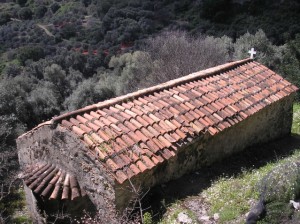
Return to the main track, fainter now, and follow it, always downhill, to meet a wider one, and turn left. This winds round the hillside, through ancient terracing, almond trees and striking agave plants, to reach Kamaria’s main, modern church, Agios Antonios. Below the church, drop below a large plane tree (and ‘picnic’ area) to meet, and turn left along the ‘main road’ into Kamaria.
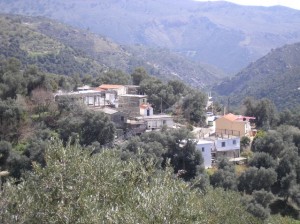 Walking through the village recently, Lynne and I fell into football conversation with a local house-owner (“This is my homeland”, he told us) but who lives in Athens. And his favourite team – Olympiakos, Panathinaikos or AEK Athens ? No … Arsenal! The impressive irrigation system will have benefitted from this winter’s above-average rainfall, and combined with warm Spring sunshine and a sheltered aspect, a bumper vegetable crop is imminent.
Walking through the village recently, Lynne and I fell into football conversation with a local house-owner (“This is my homeland”, he told us) but who lives in Athens. And his favourite team – Olympiakos, Panathinaikos or AEK Athens ? No … Arsenal! The impressive irrigation system will have benefitted from this winter’s above-average rainfall, and combined with warm Spring sunshine and a sheltered aspect, a bumper vegetable crop is imminent.
Walk through and out of Kamaria, the road surfaced but virtually traffic-free, to the church of Agios Christos. Another possible ‘picnic site’ is the nearby “Feast Day” area, this one under shady eucalyptus trees. Continue ahead for 1km on the road, rising gradually to where, below a prominent crag, a rough track branches off left. Climbing gently at first, then more steeply, this gives fine views to the sea at Sougia, and later to the north, where Psilafi mountain towers above the Agia Irini and Prines gorges. In the far distance are the wind turbines high and beyond Epanohori village.
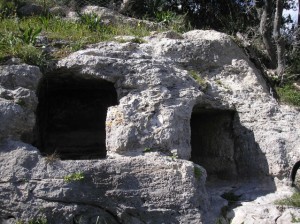
Pause on reaching the crest (short diversion left to Kefala hilltop for the view), and pick out the rock tombs above the track, which now levels out to contour around the hillside. To view these, follow the track for around ten minutes, then fork sharp right up to where the site is surrounded by wire fencing. Much more has been written about Elyros than there is to see at the main site (access from Rodovani), which is virtually nothing.
Space here only to note that Elyros was the most important Dorian city of western Crete, flourishing from the 4th century BC until 5th century AD, and probably destroyed by the Saracen Arabs in 823AD. With a population of some 16,000 inhabitants, it was mainly an agricultural city, and established trade links inland and to North Africa, with its ports at Syia (Sougia) and Lissos. Many artifacts discovered are now exhibited in Chania museum.
Return to the track and turn right, climbing slightly, for a pleasant walk of around 1 km back into Rodovani.
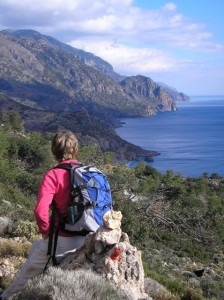 Lynne and I enjoyed this walk together just a few days before her serious illness. I am so grateful to the very many people here in Crete and around the world who are thinking of her, and sending wishes, positive thoughts and prayers for her recovery.
Lynne and I enjoyed this walk together just a few days before her serious illness. I am so grateful to the very many people here in Crete and around the world who are thinking of her, and sending wishes, positive thoughts and prayers for her recovery.


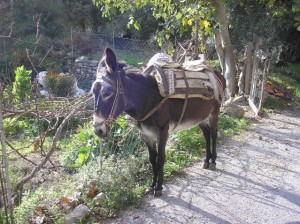
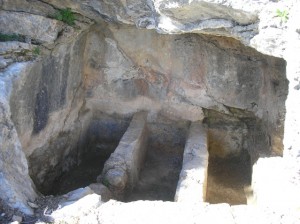

Recent Comments